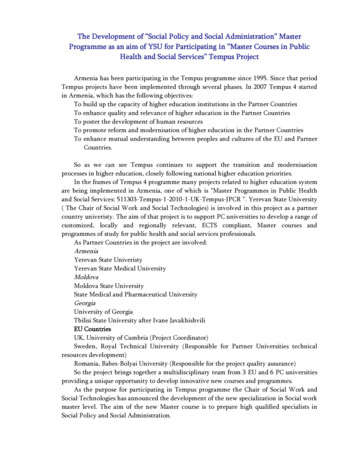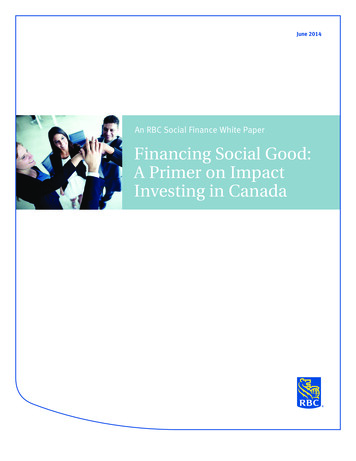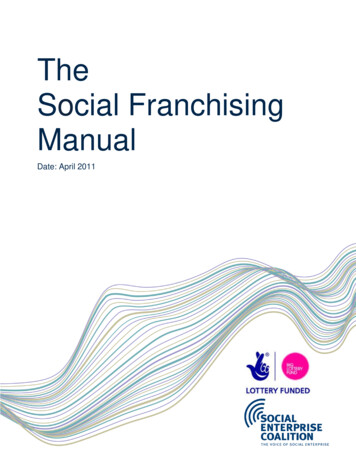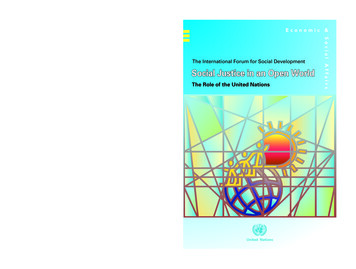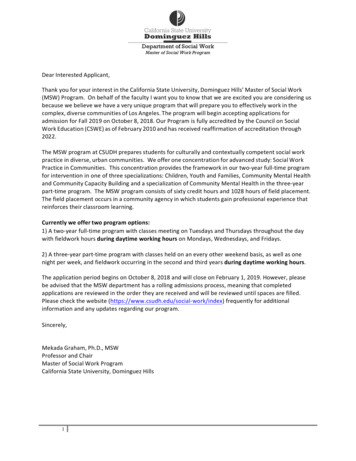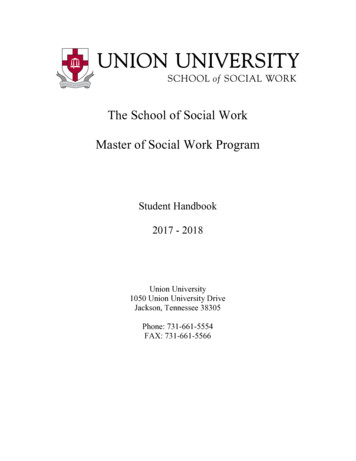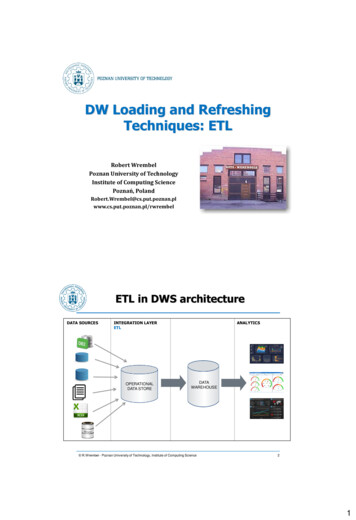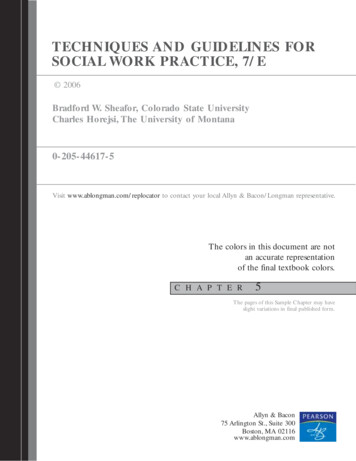
Transcription
TECHNIQUES AND GUIDELINES FORSOCIAL WORK PRACTICE, 7/E 2006Bradford W. Sheafor, Colorado State UniversityCharles Horejsi, The University of Montana0-205-44617-5Visit www.ablongman.com/replocator to contact your local Allyn & Bacon/Longman representative.The colors in this document are notan accurate representationof the final textbook colors.c hap t e r5The pages of this Sample Chapter may haveslight variations in final published form.Allyn & Bacon75 Arlington St., Suite 300Boston, MA 02116www.ablongman.com
Part V Specialized Techniquesand Guidelines forSocial Work PracticeMost of the techniques and guidelines described in prior sections of this bookcould be used by almost any social worker, in almost any social work position,in almost any human services agency. In addition to the generic tools of thesocial worker’s trade, specialized knowledge and skills are required for somesocial work practice activities. Part V concludes the book with two chapters onthese specialized aspects of social work.Some client groups require special sensitivity by the social worker. Forexample, unique insight and understanding is required to help a client dealwith the devastating impact of poverty, to serve a client who has been batteredby a spouse, or to carefully assist a client who is at risk of committing suicide.Clients from different age groups call for special sensitivity, too. Working with achild or adolescent requires knowledge of developmental factors and communication skills that are unique to young people, and at the other end of the agespectrum, older people also have unique needs that a social worker should recognize. These and other client conditions (e.g., cognitive delay, brain injury,physical disability, chemical dependence, serious mental illness, eating disorders) are often encountered in social work practice. Chapter 15 identifies guidelines for working with clients experiencing these circumstances and conditions.Another set of specialized guidelines can help the social worker obtainemployment and have a satisfying and productive experience as a socialworker. Chapter 16 presents guidelines that will assist the worker in dealingwith the demands of a social work job. Items about managing stress, preventing worker burnout, working within and coping with life in a bureaucracy, andgiving and using supervision can improve a worker’s effectiveness and efficiency. In addition, there are guidelines for performing the challenging tasks oftestifying in court and dealing with managed care. And given the times inwhich we live, items on dealing with sexual misconduct and avoiding malpractice suits have been included, as well. Finally, to support the social worker incarrying out his or her professional obligations, this chapter provides guidelines for consuming and contributing to social work knowledge, improving thesocial work image, and becoming a leader in the human services.511
15Guidelines for Workingwith VulnerableClient GroupsINTRODUCTIONSocial workers practice within a wide variety of settings, and consequently, theyencounter a wide variety of clients with a wide variety of concerns, problems, andrequests. Although it is not uncommon to find that many of the clients served by aparticular agency or program have the same presenting problem, each client is anindividual and will react to his or her situation and to the social worker in a uniqueway. Thus, social workers must always adapt their approaches and techniques tothe special needs, characteristics, and circumstances of the clients they serve.For this chapter, items were selected to illustrate how a social worker mightadapt his or her approach to the client by providing information on several differentclient groups and offering guidelines for addressing the special needs, characteristics, and challenges presented by each group. By comparing the approaches recommended for these diverse client groups, the reader will come to a deeper appreciation of why direct-service practitioners, as well as those who design and administerprograms, must always consider the uniqueness of the clients they serve. In addition, the reader will understand more clearly why an approach that works well forone group may not be appropriate for another.15.1PURPOSE:DISCUSSION:512The Client Who Is PoorTo adapt direct-service approaches to the concerns of persons living in poverty.As a profession, social work has always focused attention on poverty and the difficulties faced by persons who do not have enough resources to obtain the basics of life,such as food, shelter, and medical and dental care. Poverty has devastating effectson individuals, families, and communities. It is a contributing factor to many otherproblems, such as the breakup of families, violence, crime, substance abuse, suicide,and a multitude of health problems. Poverty is especially injurious to children because they are most vulnerable to the effects of poor nutrition, disease, family insecurity, and social instability.The causes of poverty are always complex and will vary somewhat, dependingon whether one is examining poverty in a first-world, modern country or in a third-
Chapter 15 / Guidelines for Working with Vulnerable Client Groups513world, developing country. Among the economic forces that contribute to poverty ina developed country such as the United States are recession, downturns in regionaleconomies, widespread job layoffs, shifts in the types of skills needed to secure a job,and rapid increases in the costs of essential goods and services (e.g., housing, electricity, health care). Racism and job discrimination can also restrict the economicopportunities available to whole segments of a population. And in some instances,poverty results from the social dislocation and economic disruption caused by waror political turmoil. Natural disasters, such as floods and earthquakes, can have similar social and economic effects.Even in good economic times, some individuals and groups are at risk of beingpoor, including those with inadequate education and few job skills and those whohave significant intellectual limitations, a serious mental illness, an addiction, or adebilitating health problem. Moreover, individuals and families who are economically independent can quickly slide into poverty after a tragedy such as a house fire,a serious injury or illness, or the death of the family’s breadwinner. People who areelderly and live on a fixed income are also at risk of slipping into poverty wheneverthere are significant increases in the cost of living.In the United States, many of those who are poor are the so-called workingpoor. They are holding down two or three part-time jobs but not earning an adequate income or receiving important benefits such as health insurance. Many ofthose living in poverty are mothers and their children. Families headed by youngmothers are at particular risk of being poor because many of these women lackneeded job skills. Mothers who are raising their children after a divorce are often atrisk, as well, because many fathers do not or cannot pay adequate child support. As agroup, women with limited education face special challenges; many of the jobsavailable to them (e.g., waitress, maid) pay low wages, and often the time of work forthese jobs is at night or on weekends, when child care is especially expensive andtransportation is harder to arrange.Poverty is fundamentally an issue of social and economic justice. It is alwaysrelated to the fairness of the distribution of resources and how a society addressesthe needs of all its people, especially those who are vulnerable and least able to compete in the marketplace. No matter what the cause—whether primarily individualfactors or large-scale economic forces—no person should have to live in poverty. Noone should have to go without minimum levels of food, safe housing, medical care,and protection from preventable disease and injury. Social workers, regardless oftheir practice settings and job titles, have the responsibility to collaborate with others to develop social and economic policies that will reduce the incidence of povertyand directly assist those who are poor.Social workers who directly serve individuals and families who are poor willfind this additional information and guidance useful:1. When designing or selecting an approach to working with clients who are poor,recognize that once an individual becomes poor, he or she encounters a multitudeof forces and barriers that keep him or her poor. For example, in order to get a job,an individual must have appropriate clothing, transportation, recent job experiences, and a permanent address—things that many poor people do not have. Amother who wants to work may discover that the cost of child care will consume
514Part V / Specialized Techniques and Guidelines for Social Work Practicemuch of the pay she will receive from a minimum-wage job. Working one’s way outof poverty requires not only the motivation and the capacity but also the opportunity to do so. It is a slow process that requires planning and methodically executing amultitude of small steps. Changing one’s life circumstances is difficult for anyone,but doing so when one is poor is especially difficult given the demoralizing and exhausting effects of poverty. In order to escape poverty, most people need variousfinancial subsidies and the assistance of empowering programs.2. If you frequently encounter clients living in poverty, you must have a workingknowledge of the government programs and private agencies in their communitiesthat may be of assistance. Because the causes of an individual’s or a family’s povertyare usually multifaceted, the most effective programs are those designed to addressan array of personal and family problems and issues. All such programs must be ableto address the financial emergencies that are so common among people living inpoverty. In addition to providing services for job training, job finding, job retention,and the like, programs must also address common barriers to employment, such asthe lack of child care and transportation. Providing access to higher education andtechnical training is one of the most cost-effective approaches to addressing theproblem of poverty among people who are healthy and of working age.While conventional programs that provide education and job training areneeded by and helpful to many who are poor, these programs are usually not sufficient for those people who are also suffering the psychological effects of severe childabuse and neglect, domestic violence, and other traumatic life events. Counselingand therapy must be an essential element of any successful program intended to assist these individuals.Economic self-sufficiency is certainly a desirable goal and a realistic one formany poor persons. Nonetheless, it is important to recognize that for some individuals of working age, this goal is not realistic because their capacity for work has beenseverely limited by serious and chronic conditions such as mental illness, mental retardation, brain injury, and substance abuse.3. Be alert to the fact that existing welfare policies, program rules, and eligibilitycriteria can be very real barriers or obstacles to people who are in need of assistanceand services. Client advocacy by the worker is often needed to help an individual secure needed services. Class advocacy is also necessary, but the process of changingwelfare policies and bureaucratic structures is definitely slow and difficult (see Items13.22 and 13.33).4. Understand that a client’s views about being poor are important because his orher response to current circumstances, sense of hope about the future, and level ofdistress about being poor are shaped by his or her prior life experiences and by thepeople with whom he or she frequently interacts. Among people who are poor, youwill find a variety of beliefs, attitudes, and feelings about being poor. For example, anindividual who has always been poor will view living in poverty somewhat differently than an individual who had an adequate income for many years before becoming poor. Moreover, a person who lives in a community made up of mostly poor people will view poverty differently than the person who lives in a community wherevery few people are poor. Some people who are poor, as officially measured by government standards or other objective criteria, may not define themselves as poor.
Chapter 15 / Guidelines for Working with Vulnerable Client Groups515Unless you understand the client and his or her situation, you will be unable tomake informed decisions concerning what options are possible and what might bethe best course of action for him or her. To better understand the client’s situation,keep the following questions in mind: What is the client’s specific concern, problem, or request? Is it related to alack of money or to some nonmonetary concern? What are the client’s goals, and what needs to happen in order for him or herto achieve these goals? What strengths has the client developed in order to survive and cope withhis or her very difficult circumstances? What personal and family characteristics, situational factors, and economicforces are contributing to the poverty experienced by this individual? Was there a time when the client was self-sufficient and making an adequateliving? If yes, what happened to change the situation? Did the client grow up in a family living in poverty or in a family with adequate economic resources? Has he or she always expected to be poor, or isbeing poor an unexpected development in life? Did the client grow up in a community where many others were poor? If yes,what meaning did he or she assign to being poor, and was that similar to ordifferent from most others in the community? Does the individual have family and close relatives who are poor, or is he orshe economically different from family and relatives? Has the client been abandoned or reject
ders) are often encountered in social work practice. Chapter 15 identifies guide-lines for working with clients experiencing these circumstances and conditions. Another set of specialized guidelines can help the social worker obtain employment and have a satisfying and productive experience as a social worker. Chapter 16 presents guidelines that will assist the worker in dealing
